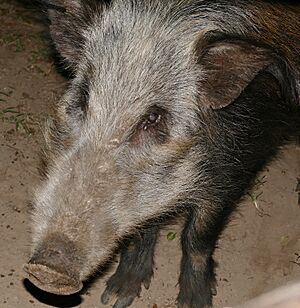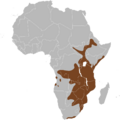Bushpig facts for kids
- "Bush pig" may also refer to the red river hog.
Quick facts for kids Bushpig |
|
|---|---|
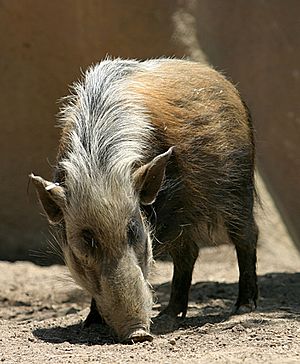 |
|
| Southern bushpig (P. larvatus koiropotamus) at the San Diego Zoo | |
| Conservation status | |
| Scientific classification | |
| Genus: |
Potamochoerus
|
| Species: |
larvatus
|
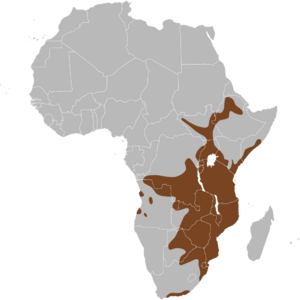 |
|
The bushpig (Potamochoerus larvatus) is a wild pig found in East and Southern Africa. It lives in forests, woodlands, and areas near rivers. You might also find them in farms. Some bushpigs have also been brought to Madagascar. There are even some reports of them on the Comoro island of Mayotte. Bushpigs are mostly active at night. They belong to the pig family.
The name 'bushpig' can sometimes refer to other types of Potamochoerus pigs too.
Contents
What Does a Bushpig Look Like?
Adult bushpigs stand about 66 to 100 centimeters (26 to 39 inches) tall at the shoulder. Male bushpigs, called boars, can weigh up to 150 kilograms (330 pounds). But usually, they weigh between 60 to 80 kg (130 to 180 lb). Female bushpigs, called sows, are smaller, weighing 45 to 70 kg (99 to 154 lb).
Bushpigs look a lot like domestic pigs. You can tell them apart by their pointed, tufted ears and a special "face mask" pattern. Their fur color changes depending on where they live. Southern bushpigs are dark reddish, sometimes almost black. Their fur gets darker as they get older. Their faces have a mix of blackish or dark brown and white or dark grey markings. Sometimes, their faces can even be completely whitish. They have long hairs that look like tassels on their ears.
Bushpigs have very sharp tusks, but they are quite short and not very noticeable. Unlike warthogs, bushpigs run with their long, thin tails pointing downwards.
Male and Female Differences
Males are usually bigger than females. Older males might grow two small bumps, like warts, on their snout.
Baby Bushpigs
Baby bushpigs are born with pale yellowish stripes on a dark brown body. These stripes disappear quickly. Their fur then turns reddish-brown. Both male and female bushpigs have a black and white mane (a line of hair) along their back. This mane stands up when the animal gets excited or scared.
Where Do Bushpigs Live?
Bushpigs are found in many places. They live from Ethiopia and Somalia down to eastern and southern DR Congo. You can also find them in South Africa. As mentioned, they live on Madagascar and possibly the Comoros islands. It's thought that humans brought them to these islands, maybe even after trying to tame them.
Bushpigs seem to have spread their range in Botswana in the late 1970s or early 1980s. However, they are very rare in Burundi.
Bushpig Family Tree
For a long time, scientists thought all bushpigs were the same species. But in 1993, a scientist named Peter Grubb suggested that bushpigs should be split into different species. He said the bushpigs from West Africa, which have more reddish fur, were a separate species. This western pig kept the name P. porcus.
The other bushpigs, including those from Madagascar, needed a new name. A scientist named Frédéric Cuvier had described the Madagascar bushpigs in 1822 as P. larvatus. Since this was the oldest name available, it became the new Latin name for the other bushpig types.
P. larvatus is very similar to P. porcus, also known as the 'red river hog'. They can even have babies together. However, P. larvatus has less reddish and coarser hair.
Scientists have recognized different types, or subspecies, of P. larvatus. Here are some of them:
- P. larvatus larvatus – found in Comoros and western Madagascar
- P. larvatus edwardsi – found in eastern Madagascar
- P. larvatus hassama – found in Eritrea, Ethiopia, and Sudan
- P. larvatus koiropotamus – found in Angola and South Africa
- P. larvatus nyasae – found in eastern South Africa and southern Tanzania
- P. larvatus somaliensis – found in Somalia
Bushpig Life and Habits
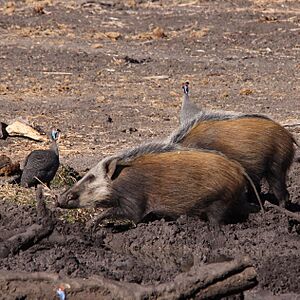
Bushpigs need thick cover to live. They avoid open forests or grasslands. You can find them in dense forests, mountain forests, thick bushveld, and even in swamps or farms. They can live at very high altitudes, up to 4,000 meters (13,000 feet) on Mount Kilimanjaro.
Social Life
Bushpigs are social animals. They live in groups called "sounders" with up to twelve members. A typical group has a dominant male and female, plus other females and young pigs. Groups usually stay away from each other. If another animal comes too close to their group, they will attack it.
A bushpig group has a home range of about 400 to 1,000 hectares (1,000 to 2,500 acres). These ranges can overlap with other groups. Some bushpigs live alone. Young males might form small groups and stay away from the main sounders to avoid fights.
Raising Piglets
Female bushpigs usually have about three young, but they can have from one to nine. The pregnancy lasts about eight to ten months. Most mating happens in late autumn to early winter. Babies are usually born in the warmest part of summer.
The alpha sow builds a large nest, about three meters (10 feet) wide and one meter (3 feet) high. She uses hay, twigs, or plant debris to keep the piglets warm. The piglets stay in this nest for about four months while they drink their mother's milk. Interestingly, the males are the main caregivers for the nest, while the sows only visit to feed the piglets.
Daily Life
Bushpigs make snorting and grunting sounds when they are looking for food or when they are scared. They are mostly active at night. During the day, they hide in very thick bushes. Leopards are their main predators.
What Bushpigs Eat and How They Interact with Humans
Bushpigs are known to be very aggressive and strong. A wounded bushpig can be very dangerous. They are fast runners and can swim well.
Bushpigs can travel up to 4 kilometers (2.5 miles) from their hiding spot at night to find food. They eat almost anything, which means they are omnivorous. Their diet includes roots, farm crops, juicy plants, rotten wood, insects, small reptiles, eggs, baby birds, and even dead animals. Tubers (like potatoes), bulbs, and fruits are very important foods for them. They also love eggs and baby birds. They will eat both fresh and very rotten dead animals. Sometimes, they even hunt and eat small young antelopes. In Uganda, they have been seen following monkeys or baboons to eat fruits and peels that fall from the trees.
Bushpigs and Farms
Bushpigs can cause a lot of damage on farms. They dig up shrubs and root crops, eating only a few and trampling the rest. They love crops like papaya, sugarcane, bananas, and maize. They will even cut down tall plants to get to the fruit. Other favorite farm foods include beans, peas, peanuts, sweet potatoes, pumpkins, potatoes, carrots, pineapples, and watermelons. They also raid chicken coops. There have even been cases of bushpigs breaking into domestic pig pens to kill and eat the pigs there.
Because of the damage they cause, bushpigs are often hunted by farmers. However, their numbers are still stable or growing in many farming areas. This is because they live in hard-to-reach places, have plenty of food, and can adapt quickly to hunting methods. They can also become a problem at camping sites, learning to raid tents for food.
In some places, like Islamic parts of East Africa, bushpig meat is not eaten because it is considered forbidden. However, in other areas, it is a delicacy. Hunters often sell bushpig meat in local markets.
Controlling Bushpig Numbers
It's hard to control bushpig numbers on farms. They quickly learn to avoid hunters. They are also very wary of new things in their territory, like traps or even a cigarette butt on their path. Using specially trained dogs can be more effective, but the dogs must be careful as boars can be dangerous. Another method is to build a strong enclosure, called a boma, and regularly put food inside for a few months. Once a whole group is used to eating there, the mechanism can be closed to trap them.
Governments in Southern Africa sometimes organize culls (planned hunts) to reduce bushpig numbers. However, these efforts have generally not been very successful.
How Bushpigs Are Protected
The IUCN (International Union for Conservation of Nature) has assessed the bushpig's conservation status. In 1993, they said it was 'not threatened'. In 2008 and 2015, it was listed as 'least concern'. This means that bushpigs are not currently at high risk of disappearing.
There isn't much international trade of bushpigs, except for a few that are sent to zoos. Bushpigs live in many well-protected areas throughout their range, which helps keep their populations healthy.
Images for kids
-
Southern bushpig (P. larvatus koiropotamus) at the San Diego Zoo
-
Two bushpigs together with helmeted guineafowl at Mapungubwe National Park in Limpopo Province, South Africa



